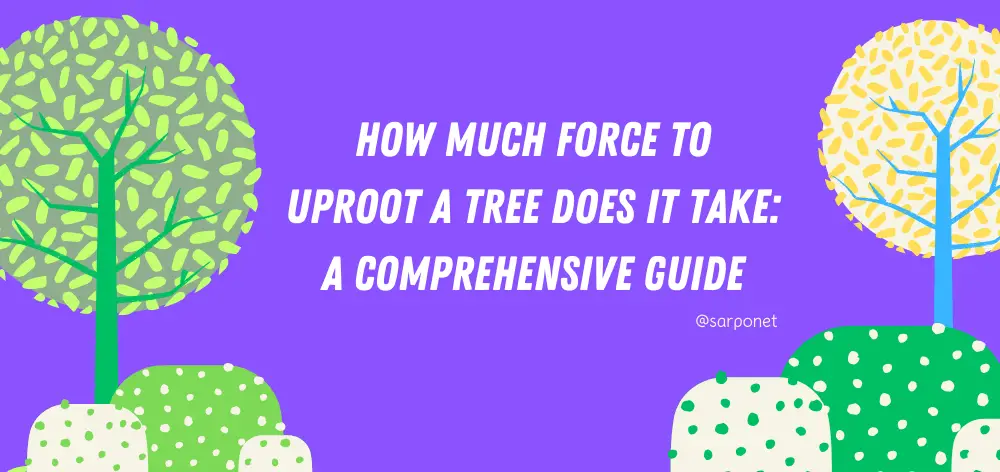
How Much Force to Uproot a Tree Does It Take: A Comprehensive Guide
The amount of force required to uproot a tree depends on several factors, including the size and type of tree, the angle at which it is growing, and the condition of the soil. Generally speaking, it takes a lot more force to uproot a large tree than a small one. The roots of trees are typically very strong and anchor the tree securely in place.
It would take an extremely powerful wind or some other form of severe weather event to uproot even a large tree.
The uprooting of a tree requires a significant amount of force. The roots of trees are designed to anchor the tree into the ground, making it difficult to remove. To uproot a tree, you must first loosen the soil around the tree’s roots.
This can be done with a shovel or other tool. Once the soil is loose, you will need to apply a great deal of force to pull the tree out of the ground. The size and type of tree will determine how much force is required.
The Mighty Tree: An Exploration of Strength and Resilience
Trees, those towering giants of the natural world, are often admired for their beauty and longevity. But beneath their leafy canopy lies a hidden strength – their roots. These intricate networks of fibrous structures anchor trees firmly to the ground, enabling them to withstand the forces of nature and remain standing through storms and seasons.
The Power of Roots: Nature’s Anchors
The strength of a tree’s root system is a marvel of engineering. These subterranean structures penetrate deep into the soil, forming a complex web that provides stability and support. The size and depth of these roots vary depending on the tree species, soil conditions, and environmental factors.
Factors Influencing Tree Strength
Several factors contribute to a tree’s overall strength and resistance to uprooting:
- Tree Species: Some tree species, such as oaks and maples, have deep, extensive root systems that provide exceptional stability. Others, like palm trees, may have shallower roots, making them more susceptible to toppling in strong winds.
- Tree Size: Larger trees, with their more massive root systems, are generally more resistant to uprooting. However, even smaller trees can be surprisingly sturdy if they have developed strong, deep roots.
- Soil Conditions: The type of soil and its composition play a crucial role in anchoring trees. Well-drained, nutrient-rich soils provide a strong foundation for roots to grow and develop.
- Tree Health: Healthy trees with vigorous growth and minimal disease or pest damage are more likely to withstand strong winds and other environmental stressors.
The Forces of Nature: When Trees Face the Elements
While trees are incredibly strong, they are not invincible. Severe weather events, such as hurricanes, tornadoes, and heavy storms, can pose a significant threat to trees, potentially uprooting or breaking them. Strong winds, combined with saturated soil, can create immense pressure on a tree’s root system, making it vulnerable to toppling.
The Challenge of Tree Removal
Uprooting a tree is a challenging task that often requires specialized equipment and expertise. The following factors influence the difficulty of tree removal:
- Tree Size: Larger trees naturally require more effort and machinery to remove.
- Root System: Extensive and deep root systems can make removal more complex and time-consuming.
- Soil Conditions: Rocky or compacted soil can hinder the removal process.
- Surrounding Structures: Trees located near buildings, power lines, or other structures may require additional precautions to avoid damage.
Professional Tree Removal: A Wise Choice
Due to the complexities involved and potential risks, it is generally advisable to hire a professional tree removal service. They possess the necessary equipment, expertise, and insurance to handle the task safely and efficiently.
Beyond the Basics: Other Factors Affecting Tree Strength
While the root system is the primary factor influencing a tree’s strength, other factors can also play a role:
- Trunk Structure: A healthy, straight trunk with strong branches provides a solid foundation for the tree.
- Crown Shape: A well-balanced crown can help distribute the weight of the tree more evenly, reducing stress on the root system.
- Age: Older trees often have deeper and more extensive root systems, making them more resistant to uprooting.
Nature’s Resilience: Trees’ Ability to Recover
Even after experiencing damage from storms or other factors, trees can demonstrate remarkable resilience. With proper care and maintenance, many trees can recover and continue to thrive. Pruning damaged branches, treating wounds, and providing adequate water and nutrients can help trees bounce back from adversity.
Frequently Asked Questions:
How strong would you need to be to uproot a tree?
Uprooting a tree requires a significant amount of strength, often beyond the capabilities of an individual. It depends on factors like the tree’s size, type, and root system. Generally, heavy machinery or a group of people with proper tools is needed for such tasks.
How much force does it take to pull down a tree?
The force required to pull down a tree varies based on its size, type, and health. It often requires several tons of force, making it impractical for an individual. Professional equipment or machinery is typically needed for safe and effective tree removal.
Can a person uproot a tree?
In most cases, no. The sheer force and specialized tools required make it a job for professionals.
What factors influence the difficulty of tree removal?
Tree size, species, health, and root structure all play a role.
How Can Grafting Trees Impact the Force Required to Uproot Them?
Grafting trees can significantly impact the force required to uproot them. In a beginner’s guide to grafting trees, it is mentioned that the union created between the rootstock and scion enhances the tree’s stability and strength. This makes it more difficult to uproot, ultimately impacting the force needed.
Conclusion
Trees are nature’s marvels, showcasing remarkable strength and resilience. However, understanding their limitations and the complexities of tree removal is crucial. Leaving tree removal to certified professionals ensures safety, protects your property, and safeguards the surrounding environment.
Related Articles:
Pine Tree Rescue: Saving Pine Trees with Brown Needles
 Dr Ahsanur Rahman, PHD
Dr Ahsanur Rahman, PHD
How to Grow Garlic Clove: A Step-by-Step Guide
 Dr Ahsanur Rahman, PHD
Dr Ahsanur Rahman, PHD




